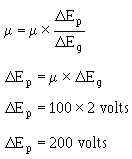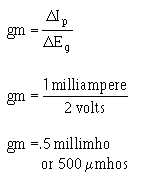1-41
Tube 2:
Thus, you can expect twice the change in plate voltage from tube 2 as from tube 1 for the same input
voltage. Therefore, tube 2 will have twice the gain of tube 1.
Transconductance
Transconductance is a measure of the change in plate current to a change in grid voltage, with plate
voltage held constant. The unit for conductance is the mho (siemens), pronounced "moe."
Transconductance is normally expressed in either micromhos or millimhos. Mathematically,
transconductance is expressed by the formula:
Examine figure 1-28, views A and B, again. In view A, the input voltage is +1 volt. At +1 volt Eg,
the plate current is equal to 1 milliampere, with a plate voltage of 250 volts. In view B, the input voltage
(Eg) is raised to +3 volts. ¨(
g, as before, is equal to 2 volts. This increase in grid voltage causes plate
current to increase to 2 milliamperes. The change in plate current (¨Ip) is then equal to 1 milliampere.
Thus, transconductance (gm) is equal to:
Remember that the voltage gain of a circuit is measured by the ratio of the change in plate voltage to
the change in grid voltage. Because plate voltage is developed across a resistor, the more current varies
with a given input signal, the greater will be the output (E = I × R). If you have two tubes, one with a gm
of 500 mhos and the other with a gm of 500 PKRV \RX FDQ HVWLPDWH WKH UHODWLYH JDLQ RI WKHVH WZR WXEHV
Assume that the circuit in which you wish to use one of these tubes has a load resistor of 100 kohms and
that ¨Eg will be 2 volts. The voltage gain of these two circuits will be:






